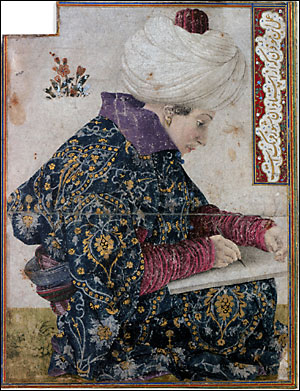In 1511 an unknown follower of the Venetian painter Gentile Bellini painted a large canvas now known as The Reception of the Venetian Ambassadors in Damascus. One of the principal loans secured by the National Gallery for its new exhibition, “Bellini and the East”, this picture – owned by the Louvre in Paris – is no masterpiece but it is a vivid testament to the perennial Venetian spirit of fascinated wanderlust. Painted in the so-called “eyewitness” style originally popularised by Bellini himself, it is not so much a topographical view of a particular corner of the city as an attempt to compress everything that made Damascus so vivid and strange, to Venetian eyes, within the scope of a single canvas: crowds of figures in turbans; a laden camel on its way to the bazaar; the great Mosque; the citadel; the public baths; private houses and their distinctive, lush walled gardens.
A train of Venetians, formally dressed in the customary black gowns and caps of their city’s patrician class, wends its way through the colourful scene, to be greeted by the Mamluk viceroy, seated magisterially on a dais. The picture was almost certainly painted for one of these visitors, as a souvenir – the most likely candidate being a gentleman named Pietro Zen, who is depicted leading the train of Venetian ambassadors. If he did indeed own the work, it would have brought back mixed memories to him. In 1512, following the arrest of a Cypriot spy bearing seditious messages from the Shah of Persia to the Venetian consul in Damascus, Zen’s ambassadorial career was brought to a sudden close. He was accused of treason by the Mamluk sultan and only narrowly escaped with his life. He left Damascus in disgrace, on foot and in chains, accompanied by a...

Bellini and the East at The National Gallery 2006
16-04-2006

